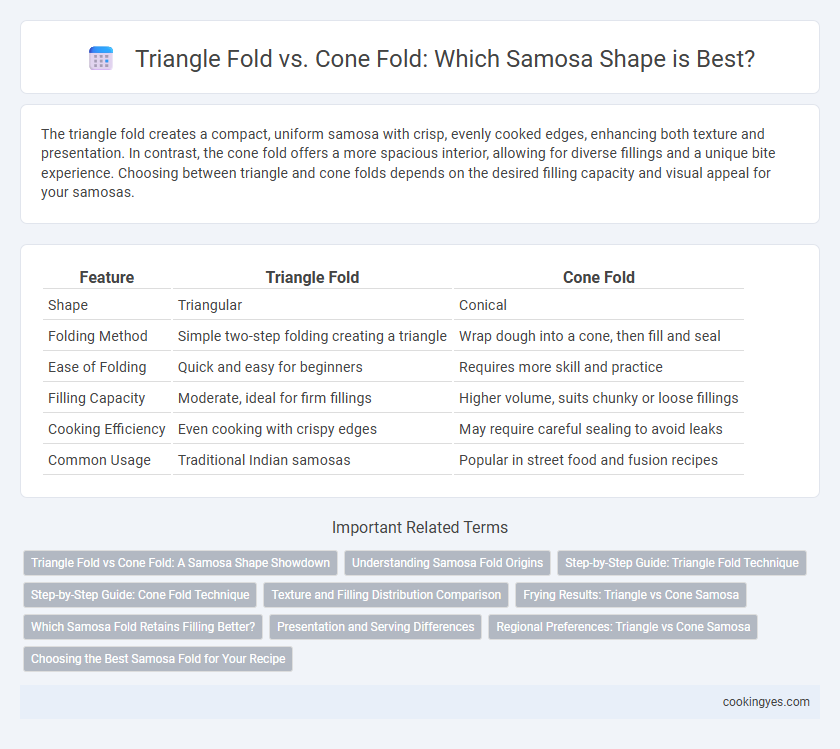The triangle fold creates a compact, uniform samosa with crisp, evenly cooked edges, enhancing both texture and presentation. In contrast, the cone fold offers a more spacious interior, allowing for diverse fillings and a unique bite experience. Choosing between triangle and cone folds depends on the desired filling capacity and visual appeal for your samosas.
Table of Comparison
| Feature | Triangle Fold | Cone Fold |
|---|---|---|
| Shape | Triangular | Conical |
| Folding Method | Simple two-step folding creating a triangle | Wrap dough into a cone, then fill and seal |
| Ease of Folding | Quick and easy for beginners | Requires more skill and practice |
| Filling Capacity | Moderate, ideal for firm fillings | Higher volume, suits chunky or loose fillings |
| Cooking Efficiency | Even cooking with crispy edges | May require careful sealing to avoid leaks |
| Common Usage | Traditional Indian samosas | Popular in street food and fusion recipes |
Triangle Fold vs Cone Fold: A Samosa Shape Showdown
Triangle fold samosas offer a classic, crisp texture with evenly distributed filling, enhancing the bite experience. Cone fold samosas provide a unique shape that allows for more versatile stuffing and a visually appealing presentation. Choosing between triangle and cone folds depends on the balance between traditional aesthetics and innovative filling capacity.
Understanding Samosa Fold Origins
The triangle fold of samosas traces its origins to Middle Eastern and Central Asian culinary traditions, where triangular pastries were common, symbolizing cultural adaptation over time. The cone fold, often found in South Asian and Indian street food, evolved to facilitate easier filling and frying, reflecting regional cooking methods. Understanding these folds reveals the historical and practical influences that shaped the iconic samosa shapes seen in diverse cuisines today.
Step-by-Step Guide: Triangle Fold Technique
Create the samosa wrapper by cutting a circle into two halves, then forming a cone shape by overlapping the straight edges and sealing with water or flour paste. Fill the cone with the spiced potato or meat mixture, leaving space to seal the open edge. Firmly press and fold the open edges in a triangular pattern, ensuring all sides are tightly sealed to prevent filling leakage during frying.
Step-by-Step Guide: Cone Fold Technique
The cone fold technique for samosas involves shaping a paper-thin dough strip into a cone by folding one corner at a time, ensuring even and secure sealing to prevent filling leakage during frying. Start by folding the strip into a small triangle at the end, then continue wrapping and overlapping the dough while sealing edges with water or flour paste. This method creates uniform, airtight cones ideal for holding thick fillings, resulting in crisp and well-shaped samosas.
Texture and Filling Distribution Comparison
Triangle fold samosas offer a crispier texture due to even heat exposure on all three sides, enhancing the flaky pastry experience. Cone fold samosas typically provide better filling distribution as the elongated shape allows for a thicker, more uniform filling layer without leakage. Texture preference depends on cooking method, but filling consistency is more reliably maintained in cone-shaped samosas.
Frying Results: Triangle vs Cone Samosa
Triangle fold samosas provide even frying due to their flat surface, resulting in a uniformly crispy texture and well-cooked filling. Cone fold samosas, with their hollow center, tend to retain more oil and may have inconsistent crisping, especially around the thicker base. Frying efficiency favors triangle folds for quicker, less oily, and evenly cooked samosas.
Which Samosa Fold Retains Filling Better?
The triangle fold of samosas creates a compact and tightly sealed pocket that effectively retains the filling during frying or baking, minimizing leakage. In contrast, the cone fold, while visually appealing, tends to have larger gaps at the edges, increasing the risk of filling spilling out. Therefore, the triangle fold is generally preferred for better filling retention and a crisp texture.
Presentation and Serving Differences
Triangle fold samosas showcase a traditional, uniform shape ideal for consistent presentation, allowing easy stacking and appealing symmetry on serving platters. Cone fold samosas provide a modern aesthetic with a more open interior, enhancing filling visibility and creating a visually dynamic dish ideal for gourmet settings. Serving differences highlight that triangle folds maintain crispness evenly, making them perfect for finger foods, while cone folds offer varied textures and easier dipping with sauces.
Regional Preferences: Triangle vs Cone Samosa
Triangle fold samosas dominate North Indian and Pakistani cuisines, prized for their crisp edges and even filling distribution. Cone fold samosas are preferred in South Indian and Middle Eastern regions, offering a compact shape that enhances frying uniformity and portability. Regional variations in folding styles impact texture, cooking time, and presentation, reflecting cultural culinary identities.
Choosing the Best Samosa Fold for Your Recipe
Choosing the best samosa fold depends on the desired texture and filling retention; the triangle fold offers a crispier edge and evenly distributed filling, ideal for traditional, bite-sized samosas. The cone fold allows for larger, stuffed samosas with more filling capacity but may require careful sealing to prevent leaks during frying. Assessing your recipe's filling consistency and preferred cooking method will help determine whether the triangle or cone fold enhances your samosa's flavor and presentation.
Triangle fold vs cone fold for samosa shape Infographic

 cookingyes.com
cookingyes.com